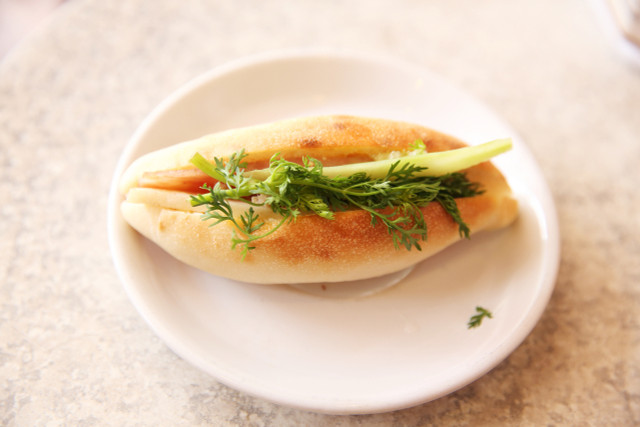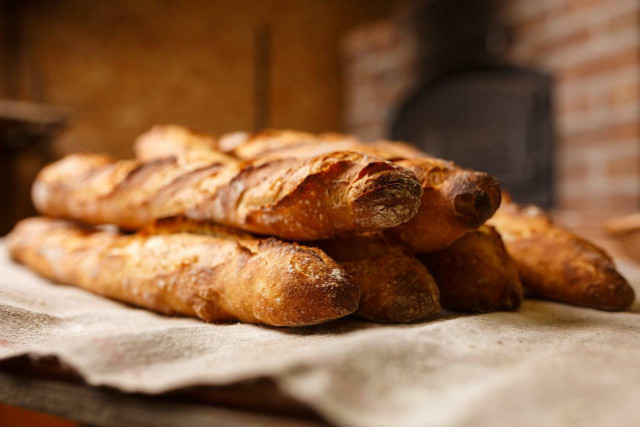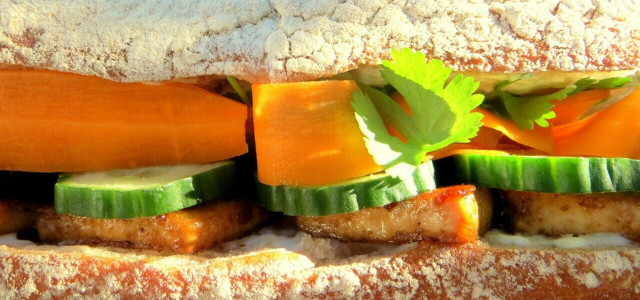Our recipe for a vegan bánh mì lets you enjoy this Vietnamese street food staple at home. You can also mix and match with our tasty additions to build your perfect sandwich. Let’s get started.
The origin of the bánh mì sandwich purpotedly dates back to the middle of the nineteenth century, when France entered Vietnam as colonizers. Vietnamese and French cuisine began to mix, and around the 1950s locals began serving soft French baguettes with spread of cold meats, butter, cheese, and pâté.
Today, it’s become a favorite of Vietnamese people (and tourists) and can be found in many street food stalls around the world. Meat, pickled and/or fresh vegetables, sauces, and fresh herbs are just some of the common additions to a bánh mì.
We will teach you how to prepare a vegan version of the bánh that uses marinated and fried tofu in place of the pork. You’ll need to prepare the pickled vegetables in advance, so be sure to complete that step first.
How to Make Pickled Vegetables
To let your vegetables pickle properly in order to get that authentic bánh mì taste, we recommend that you let them prepare these first and let them chill for at least an hour prior to preparing your sandwich.
Ingredients:
- 1 small carrot, peeled and cut into thin strips
- ½ small red onion, finely sliced
- 2 small radishes, also thinly sliced – or substitute daikon radish if preferred.
- 1 small pickling cucumber, thinly sliced – or regular cucumber, peeled
- ½ cup rice vinegar
- Pinch of salt and sugar
- Optional: 1 medium jalapeno, seeded and sliced into thin strips
Instructions:
- Fortunately, the pickling procedure is straightforward. In order to make the pickled vegetables, simply arrange them in a bowl or jar and cover them with rice vinegar. For best results, toss the contents a couple of times before setting them set aside for later.
Simple Vegan Bánh Mì Recipe

(Foto: Colourbox.de / Utopia)
Yield: 2 sandwiches
Ingredients:
- 1 tbsp. organic, unrefined olive oil
- 2 tbsp. soy sauce
- 2 tbsp. lime juice
- 1 tbsp. maple syrup
- 2 cloves garlic
- 1/2 tsp. grated ginger
- A pinch of red chili flakes
- 14 oz. of tofu, drained and sliced
- 2 servings of baguette, or a similar crusty bread, sliced in half lengthwise
- Pickled vegetables
- 1/2 cup vegan mayo
- A few sprigs of cilantro for garnish
Instructions:
- Put the olive oil, soy sauce, lime juice, maple syrup, garlic, ginger, and chili flakes in a small bowl and mix well.
- Spread the tofu out in a bowl and drizzle the marinade over it. To ensure even coating, flip the tofu and apply extra tamari if desired. Make sure the tofu has marinated for at least 15 minutes.
- In a skillet that won’t stick, add some oil to the pan and arrange the tofu pieces so that there is room between them.
- Let the tofu slices fry for a few minutes on each side without disturbing them too much so that they get thoroughly golden brown and caramelized on the edges. Take it off the heat and season it to your liking.
- Next, spread some vegan mayo on the baguettes and add the pickled vegetables and cilantro for a garnish.
Tip: For extra spice, make your own vegan sriracha mayo instead of regular vegan mayo.
Vegan Bánh Mì Ingredient Swaps



(Foto: CC0 / Pixabay / Intuitivmedia)
Today’s Vietnamese baguettes are typically made with a combination of rice flour and wheat flour for a fluffier texture. You don’t need to go out of your way to find traditional Vietnamese bread; any baguette-style bread with a crunchy crust will do the trick.
Make a vegan, gluten-free banh mi by swapping out the bread with a gluten-free variety and using homemade tempeh made entirely of soybeans and without grains.
Whenever possible, we advise going the organic route to protect yourself and the environment from synthetic chemical pesticides and to promote responsible farming practices. Furthermore, the simplest way to find out what kinds of veggies are in season and hence available in your area is to consult a seasonal calendar. This reduces the need for long transit routes, which are a major contributor to pollution and higher CO2 emissions.
Read more:
- 5 Quick & Easy Vegan Sandwiches
- Sriracha Mayo Recipe (+ Vegan Version)
- How to Ferment Vegetables: A Beginner’s Guide
Do you like this post?







